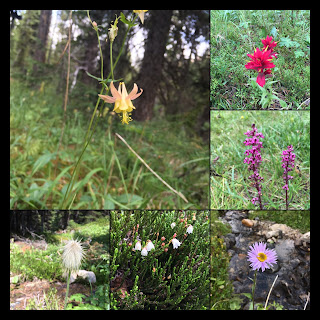 |
| Lincoln's Sparrow |
The flurry of new life and birdsong subsided as the warmer,
longer days of summer came on. The neighbourhood seemed quiet as birds got down
to the important work of finding food for their fledged young. With the trees
back to full-leaf it became difficult to see birds; with the addition of
juvenile birds to the mix, I found it tricky to identify what I was seeing at
all. I turned my attention to the explosion of wildflowers in bloom and my bird
counts fell to the wayside.
A couple of trips outside of the city were in order to see
some new (to me!) birds. The first was a quick drive out to the Langdon
sloughs. How did I not know that these exotic-looking species lived so close
by? Along with American Avocets, Wilson’s Phalaropes, countless Redwinged Blackbirds, ducks and geese I saw the following:
 |
| Black Tern |
 |
| Black-necked Stilts |
A weekend in
the backcountry at the end of July yielded another fun surprise. As we
descended from Molar Pass in Banff National Park toward the highway, we saw a
Spruce Grouse on the trail ahead. She sat so still as we approached. As we got
closer we noticed vibrating balls of yellow fluff coming from under her wings –
almost as if she were covered in bumble bees. Just then she stood up to walk
away and four tiny chicks emerged from under her wings, following her into the
forest.
 |
| Spruce Grouse and chicks |
Back in Calgary, my suburban backyard was pretty quiet. I
caught a quick glimpse of a Rufous Hummingbird in July but the weeks wore on
without any other notable sightings. All of that changed, though, come
mid-August, when there seemed to be a new bird to identify almost every day.
First came the Flycatchers. Any bird watcher will tell you that the birds in the Empidonax genus are among the most difficult to identify down to the species
level. They are difficult to identify by sight and are best distinguished by
their song. Unfortunately they were extremely quiet as they feasted on the berries of my Dogwood shrub and caught the small insects that flew by. With some expert help from Wlad, my ever-helpful teacher, we narrowed this first one down to the Pacific-slope Flycatcher.
 |
| Pacific-slope Flycatcher |
 |
| Empidonax Flycatchers |
Then came the Eastern Kingbird – another Flycatcher, but not
from the genus Empidonax. This bird’s latin name is Tyrannus tyrannus and is much easier to identify than its
flycatching cousins.
 |
| Eastern Kingbird |
Up until this point in my Year of the Bird I had not seen a
Vireo of any kind. Then this Warbling Vireo showed up on my Mayday Tree.
 |
| Warbling Vireo |
In the following weeks I would add three more Vireos to my
life list. A Blue-headed Vireo spotted at Confederation Park, a Philadelphia
Vireo in my backyard, and a Red-eyed Vireo at Carburn Park. The Red-eyed Vireo
was smart to flee the scene as a Sharp-shinned Hawk came through.
 |
| Philadelphia Vireo |
 |
| Red-eyed Vireo |
 |
| Sharp-shinned Hawk |
Then came the Warblers, the best of all. There is such a
variety of Warblers that come through Calgary during migration. Identifying
Warblers is a fun challenge. I spent many hours taking pictures of them as they
came through the yard, examining my pictures for field markings, and then
sending my pictures to Wlad to help with
identification. The Wilson’s and Yellow-rumped Warblers were the most common to
spot and easy to identify.
 |
Wilson's Warbler
|
 |
Yellow-rumped Warbler
|
With a little experience, I was able to differentiate
between the Orange-crowned and Tennessee Warbler.
 |
| Orange-crowned Warbler |
 |
| Tennessee Warbler |
And then this beauty. Using my Sibley’s Field Guide and my
new favourite app – The Warbler Guide
I learned this was a Townsend’s Warbler.
 |
| Townsend's Warbler |
Summer may have started slow, but by the time Autumn
officially arrived, the birds were coming through at a frantic pace. I was
loving every minute of it.
 |
| White-throated Sparrow |
 |
Citizen Science in Action
|




















Comments
Post a Comment